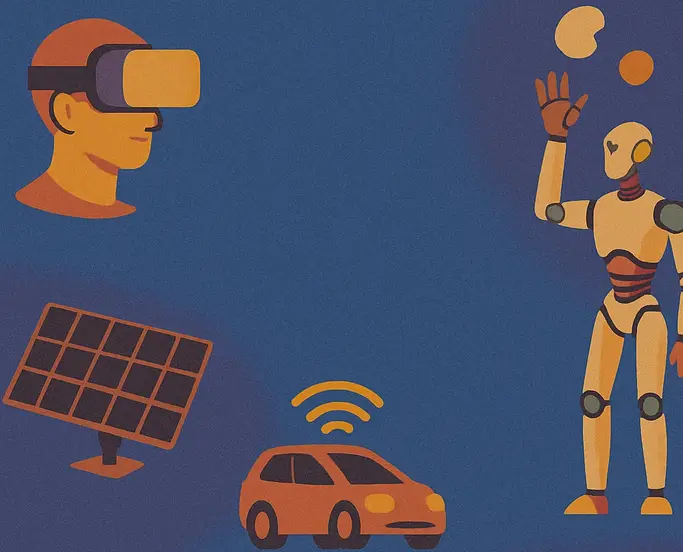In the first part of this series, we explored 17 groundbreaking technologies shaping 2026. But the story doesn’t end there. Today, we’re diving into 15 more innovations that are set to define the way we live, work, and connect. From self-healing materials to satellites blanketing the globe with internet, these trends are happening right now and will fundamentally transform our world.
Table of Contents
1. MicroLED and Next-Gen Displays: Brighter, Better, Longer-Lasting
TVs, AR glasses, and smartwatches are about to look very different. MicroLED displays are now making their way into consumer products after years of R&D. Unlike OLEDs, microLEDs don’t rely on organic compounds, which means no burn-in and much longer lifespan. Samsung showed off massive microLED walls at CES 2024, and Apple is reportedly working on adding microLED to future Apple Watch models.
Industry analysts project the global microLED market will reach about $10 billion by 2030. The big draw is brighter screens, richer colors, and lower power use. That’s crucial for wearables and AR/VR headsets where every bit of battery life counts. These displays will revolutionize how we interact with technology, providing clearer visuals and more efficient energy consumption.
2. Transparent Displays and Holographic Interfaces: The Future of Interaction
Imagine a car windshield that doubles as your navigation screen or a shop window that projects holographic ads you can interact with. That’s where transparent and holographic displays are heading. LG has already demonstrated 77-inch transparent OLED panels, and Panasonic tested transparent display tech in retail environments in Japan. At CES 2024, Samsung unveiled a transparent microLED prototype that stole headlines.
These displays don’t just look futuristic; they offer practical benefits like heads-up navigation for drivers and interactive medical imaging for hospitals. By 2026, we’ll likely see the first wave of real-world deployments, transforming how we interact with information in our daily lives.
3. Voice and Emotion AI: Machines That Understand How You Feel
Talking to machines is getting less robotic. Emotion AI, sometimes called affective computing, is trained to detect human emotions through tone of voice, facial cues, and word choice. Companies like Smart Eye and Affectiva are already embedding this tech into cars, analyzing driver fatigue and distraction in real time. In healthcare, researchers are testing it for early detection of stress and depression.
A recent market report by Markets and Markets projects the emotion AI industry will grow to $49 billion by 2029. This shift means AI systems won’t just respond to what you say, but how you say it, creating more natural and empathetic interactions between humans and machines.
The Next Frontier: Emotionally Intelligent Machines
Emotion AI is redefining how we interact with technology — making it more human, intuitive, and responsive. As this $49B industry accelerates, new roles in AI psychology, data ethics, and human–computer design are emerging faster than ever. The future of AI isn’t just about logic — it’s about empathy.
Explore Emotion AI & Human-Tech Jobs →4. Autonomous Everything: Drones, Ships, and Trucks
Autonomous cars often dominate headlines, but the bigger story is how autonomy is spreading across everything. In 2024, China’s Pinduoduo completed thousands of deliveries using autonomous drones. In Europe, the Norwegian container ship Yara Birkeland began operating with remote and autonomous navigation, marking the world’s first fully electric container ship. Meanwhile, in the US, companies like TuSimple and Aurora are testing self-driving trucks on long-haul routes, with some operating over a million miles in pilot runs.
By 2026, it won’t just be cars. Entire logistics chains will be running with minimal human intervention, revolutionizing supply chains and transportation systems across the globe.
5. Blockchain Beyond Finance: Supply Chains and Digital Identity
Blockchain isn’t just about cryptocurrency anymore. Governments and corporations are deploying it to verify supply chains, secure digital identities, and reduce fraud. The European Union has been piloting blockchain for cross-border customs and logistics, while IBM’s Food Trust platform is being used by Walmart to track produce safety from farm to shelf. South Korea rolled out a blockchain-based digital ID for citizens, aiming to replace physical ID cards.
Analysts at PwC estimate blockchain could add $1.7 trillion to the global economy by 2030, with most of that value outside of finance. This technology will become essential for ensuring transparency and security in our increasingly digital world.
6. Advanced Cybersecurity: AI and Quantum Resistance
Cyber threats are growing as fast as the technology protecting against them. In 2023, the US saw over 3,200 reported ransomware incidents, according to the FBI’s IC3 report, a 74% increase from the year before. AI-driven cybersecurity tools are now being trained to spot anomalies in real time, identifying breaches before they spread.
At the same time, researchers are developing quantum-resistant encryption. The US National Institute of Standards and Technology (NIST) has already selected new post-quantum cryptographic algorithms, preparing for a world where quantum computers could break today’s encryption in seconds. This dual approach will be crucial for protecting our digital infrastructure.
7. Hyper-Personalized AI Tutors: Education Revolution
Education is going through a shift similar to what we’ve seen in entertainment and shopping. Instead of one-size-fits-all lessons, AI tutors adapt in real time to how a student learns. Khan Academy launched Khanmigo, an AI-powered guide that helps students with math, science, and coding while also assisting teachers with lesson planning. Duolingo uses AI to personalize language lessons, serving over 80 million monthly users worldwide.
Global Market Insights projects that the AI in education market could surpass $30 billion by 2032. By 2026, AI tutors may become as common as textbooks once were, revolutionizing how we learn and teach.
8. Self-Healing Materials: The Future of Durability
Materials that repair themselves aren’t just science fiction anymore. Researchers at the University of Manchester developed a self-healing aerospace material that can autonomously patch small cracks in aircraft components. In 2023, LG Chem showcased self-healing coatings that restore scratches on car surfaces within minutes under heat. The potential extends to consumer electronics where cracked phone screens may eventually fix themselves without a trip to the repair shop.
Markets and Markets estimates the self-healing materials industry could grow to over $4 billion by 2027, with applications in automotive, aerospace, and infrastructure leading the way. This technology will extend the lifespan of products and reduce maintenance costs across industries.
9. Nanotechnology: Medicine and Electronics Revolution
When you shrink technology down to the nano scale, you open up whole new possibilities. In medicine, researchers are exploring nanoparticles that deliver chemotherapy drugs directly to tumors, reducing side effects. MIT and Brigham and Women’s Hospital have developed nano-sensors that can detect cancer biomarkers in blood. In electronics, nano-scale transistors are already pushing Moore’s law further, with IBM unveiling a 2-nanometer chip in 2021 that promises major gains in performance and energy efficiency.
The global nanotechnology market is projected to surpass $250 billion by 2030, showing just how central this field is becoming to technological advancement.
10. Digital Twins: Virtual Replicas of Reality
Digital twins, real-time virtual replicas of physical systems, are expanding fast. Singapore has already built a national digital twin to simulate urban planning, monitor traffic, and manage energy use. In manufacturing, companies like Siemens and GE use digital twins to model factories and machines, cutting downtime and improving efficiency. During the 2020 Tokyo Olympics, organizers tested digital twin technology to manage crowd flow and logistics.
Analysts at Deloitte predict that by 2026, nearly 70% of large industrial companies will use digital twins in some form, making them a core part of operations and decision-making.
11. Space-Based Internet: Global Connectivity from Above
Getting online anywhere on Earth is becoming a reality. SpaceX’s Starlink already has over 6,000 satellites in orbit, serving more than 3 million subscribers as of mid-2025. OneWeb, Amazon’s Project Kuiper, and China’s Guowang constellation are racing to expand coverage too. These networks are targeting rural areas, disaster zones, and developing countries where laying fiber is too costly.
By 2026, satellite internet will be more than a backup; it will be part of everyday global infrastructure, ensuring connectivity reaches every corner of the planet.
12. 6G Networks: The Next Generation of Connectivity
5G is still rolling out worldwide, but work on 6G is already in motion. South Korea, Japan, and Finland are leading trials with commercial deployment expected around 2030. 6G aims to use terahertz frequencies to deliver speeds up to 100 times faster than 5G and latency as low as 100 microseconds. That’s fast enough to support real-time holograms, autonomous fleets, and massive IoT ecosystems.
The ITU has begun setting 6G standards while companies like Nokia and Samsung are actively developing hardware. By 2026, early 6G pilots will give us a glimpse of the post-5G world.
6G: Building the Infrastructure of Tomorrow
The race to 6G has already begun — with terahertz frequencies, ultra-low latency, and the power to connect everything in real time. From autonomous vehicles to holographic communication, 6G will transform how industries operate and how humans interact with machines. The next decade belongs to those who help build the network that powers it all.
Explore 6G & Next-Gen Connectivity Careers →13. Sustainable Tech and Green Computing: The Environmental Imperative
With data centers now consuming around 1 to 1.5% of the world’s electricity, efficiency has become critical. Google, Microsoft, and Amazon are racing to power their data centers with renewable energy, while chip makers like Nvidia and AMD are optimizing for performance per watt. Carbon capture startups are using AI to scale up efficiency, and researchers are designing fully recyclable electronics.
In 2024, Microsoft announced it had achieved 100% renewable energy coverage for its global operations. By 2026, green computing will no longer be optional; it’ll be baked into how the tech industry operates.
14. Advanced Neurotechnology: Beyond Brain-Computer Interfaces
Brain-computer interfaces grabbed headlines when Neuralink implanted its first chip in 2024. But neurotechnology is much broader. Researchers are testing non-invasive brain stimulation to treat depression and PTSD, while companies like Kernel are developing helmets that can monitor brain activity with unprecedented detail. Clinical trials are exploring personalized brain therapies for epilepsy and Alzheimer’s.
In 2023, the US NIH launched its Brain Initiative 2.0, investing billions in advanced neurotechnology. By 2026, these innovations could expand from medical use into wellness and cognitive enhancement.
15. Synthetic Biology: Engineering Life Itself
Synthetic biology is pushing science into new territory. Using AI-guided gene editing, researchers are engineering organisms to produce biofuels, biodegradable plastics, and even synthetic meat. In 2023, Ginkgo Bioworks announced partnerships to design microbes that can manufacture sustainable chemicals at scale. Moderna and BioNTech are expanding mRNA technology beyond COVID vaccines to treat cancer and rare genetic diseases.
The global synthetic biology market is expected to surpass $30 billion by 2030. By 2026, the line between biology and technology will blur even further, making synthetic biology one of the most transformative fields of the decade.
The Convergence: How These Technologies Work Together
These 15 technologies represent more than individual innovations; they represent a convergence that will reshape our world. From the materials we use to the way we connect and even how we think, these trends are happening right now and will fundamentally transform every aspect of human life.
The future is not just coming; it’s here. These technologies show how quickly innovation is moving beyond our screens and into every corner of our lives, creating a more connected, efficient, and sustainable world for 2026 and beyond.




